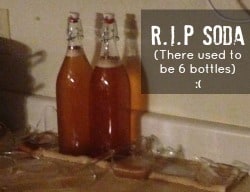We’ve done DIY Sodas before, but never went into detail about creating yeast sodas. This is just another great way to capture the amazing flavors that the Spring and Summer have to offer.
Proceed with Caution! Contents can be tastier than they appear
How to do it:
Before you Begin:
Before you begin, make sure that all of your equipment is sterilized. You don’t want other organisms messing with your soda.
If you are planning on serving yeast sodas in your beverage program, make sure to check with your local laws to ensure it is legal to do so.
Let’s make soda!
- Juice the fruit/vegetables that you will be using.
- Create a small amount of simple syrup and add any flavoring that you want in your final soda. I chose to use Watermelon as my fruit and Serrano peppers and Oregano for my simple syrup. Go very light on your sugar as there is plenty of sugar in the fruit, I suggest starting with 2 parts of water to one part of sugar. I only ended up using about half a cup of this mixture in the soda.
- Dissolve the yeast (I used less than 1/8th of a teaspoon per batch) in warm water and 10 minutes later add a small amount of the flavored syrup. Let this sit for 20 minutes more and then add everything to your juice.
- Pour everything into a clean 2 liter soda container and put into a cool dark place for 48 hours.
- When you can’t compress the soda bottle, you are ready to filter and replace the soda in it’s final bottle.
Tips:
- This is the yeast that I used (affiliate link)
- Use recycled Soda Bottles as they can handle a much higher pressure than glass.
- You only need a small amount of yeast per soda bottle. Yeast will continue to multiply as long as there are nutrients to consume.
- You can use bottled juice instead of fresh juice to make your soda.
- Try on keep the temperature down to around 50-60 degrees Farenheit. The champagne yeast (affiliate link) that I was using produces off flavors as the fermentation temperature rises. The wine room may be a great place to do create your sodas.
- Remember that there is a lot of pressure and solid material in the soda, slowly relieve pressure when opening the soda around guests.
- Yeast can be sensitive to pH, temperature, and alcohol concentration. All of these can be ways to stop the yeast from creating more CO2.






What would you recommend storing the soda in once the process is completed. Could you simply pour theses into small glass bottles and crown cap them or would you have to utilise a vacuum set up to ensure the carbonation is not lost.
Hi Michael,
Losing carbonation with yeast soda’s has not been an issue for me in the past. Yeast will continue to consume sugar and releasing CO2 as a by product until everything is consumed.
Swing top beer bottles are a good way to store the soda’s, but make sure that they are in a cold environment so the yeast goes dormant. The beer bottles can stand a higher pressure than just your average cute swing top bottle from the container store.
http://www.amazon.com/CASE-OF-12-Bottles-CLEAR/dp/B0064ODUDK/ref=sr_1_5?ie=UTF8&qid=1405454627&sr=8-5&keywords=swing+top+bottles
They also make plastic soda bottles with screw caps you can buy as well.
http://www.amazon.com/P-E-T-Liter-Beer-Bottle-case/dp/B0064OG6AO/ref=sr_1_1?ie=UTF8&qid=1405454761&sr=8-1&keywords=plastic+soda+bottles
You can crown cap regular beer bottles, but be careful about the pressure. If pressure begins to build up again, when you uncap the beer bottle you will be wearing the contents.